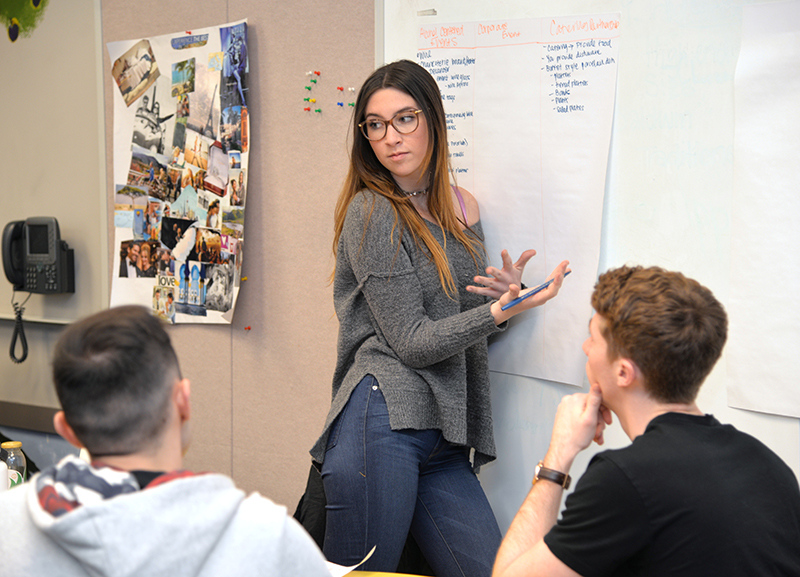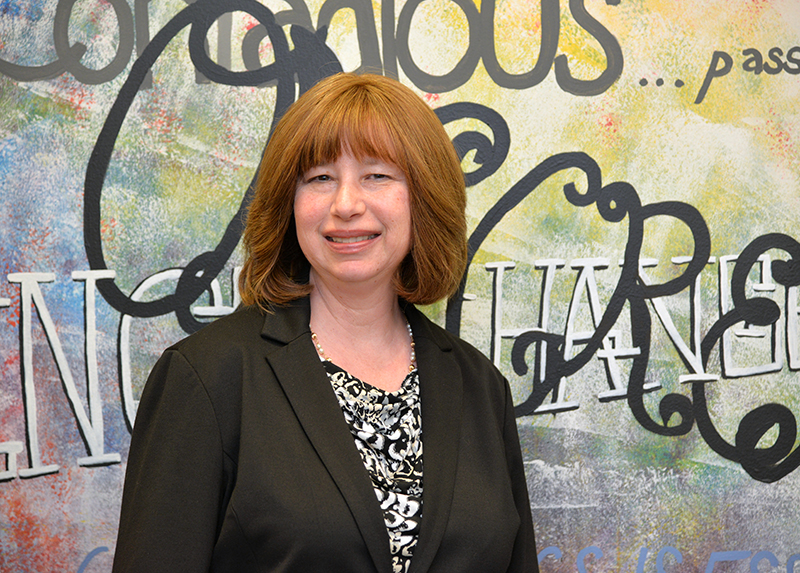College of Business > News & Events > Students Learn Design Thinking to Accelerate Innovation
Students Learn Design Thinking to Accelerate Innovation
By Andrew Zamorski. Photos by Kathy Hillegonds /
April 20, 2017 /
/
Facebook
Main Content
 Wouldn’t
it be nice if DePaul University had napping pods for students to sleep in? Free
snacks offered on every floor? Phone charging stations in each classroom?
Wouldn’t
it be nice if DePaul University had napping pods for students to sleep in? Free
snacks offered on every floor? Phone charging stations in each classroom?
These are a few of the ideas that emerged from a DePaul-themed WIBNI (Wouldn’t It Be Nice If) introductory exercise taught in Management Professor Lisa Gundry’s
Creativity and Business class. WIBNI is a creative thinking tool that falls
under design thinking—an approach to creativity and innovation that is becoming
an important part of business and business education at DePaul.
“Design thinking is a multi-stage process that is useful for innovation,” says Gundry. “What's important about it, and what sets it apart from other creative
problem-solving models or innovation models, is that it starts with customer-
or user-discovery or inquiry.”
Design thinking was created by Tim Brown, chief executive officer and president of
IDEO, an international design and consulting firm. Brown noted that design
projects go through three phases: inspiration (exploration of a problem
through a customer or user point of view), ideation (generating, developing and
testing ideas and potential solutions) and implementation (navigating the path
to market). Design thinking encourages speaking with users experiencing “pain
points” – which are real or perceived problems – and coming up with innovative
solutions to solve them.
“It is really useful for students to learn design thinking because it is tempting
for people to think that ideas start with themselves when they are designing
for other people,” says Gundry. “Even if you are part of the group you are
designing for, you need to talk to other people about their experiences.”
Design thinking was formally integrated into DePaul innovation classes a year ago. In coursework for undergraduate and graduate students in Gundry’s and Professor
Javier Monllor’s creativity and innovation business courses, design thinking is
being taught as a framework. Students learn the framework theoretically and
then they apply it to real situations in teams.
 Professor Lisa Gundry “Design
thinking is going to help you become a better problem solver,” says Gundry.
“The better you are at problem solving, the more likely you are going to be
successful. One of the best ways that businesses can stay competitive and grow is to better identify the problems faced by customers and
users so they can design effective solutions to them.”
Professor Lisa Gundry “Design
thinking is going to help you become a better problem solver,” says Gundry.
“The better you are at problem solving, the more likely you are going to be
successful. One of the best ways that businesses can stay competitive and grow is to better identify the problems faced by customers and
users so they can design effective solutions to them.”
Gundry invites local businesses into the classroom to work with students during
ideation sessions. Ideation, a part of design thinking, is the creative process
of developing new ideas and solutions through visual, concrete or abstract
exercises—including the WIBNI tool. Before the session, students do background research on the challenge, and try to understand the customer or user experience. Then, the ideation session takes place and in about two to three hours students apply their design thinking skills to brainstorm with the clients, present pain points for users and generate ideas and potential solutions that can be tested.
Brittany Nicholson, a current student earning her Master of Science in Hospitality
Leadership and Operational Performance, recently took Gundry’s Creativity and
Business course and found the design thinking tools and ideation sessions to be
beneficial.
“I never heard about design thinking before taking Professor Gundry’s course,”
says Nicholson. “I really grew to love the tools and concepts and this quickly
became one of my favorite courses. I know that I will be able to use these
concepts in my future career in hospitality.”
A popular sports bar and gastropub served as the client for Nicholson’s
ideation session in Gundry’s class. The restaurant approached the class with a
common issue in the hospitality industry—how to keep millennial employees engaged
and reduce the turnover rate. Under Gundry’s supervision as well as input from
the company's management team, the class proceeded to use design thinking tools to
brainstorm ideas. Nicholson’s group developed ideas for management to
provide employees the opportunity to volunteer give back to the community,
which would make the employees feel more appreciated at work.
“The design thinking tools can be used in any business situation,” says Nicholson.
“These tools help management see challenges employees and customers are facing
and can help create solutions that work.”
As the director of DePaul’s Center for Innovation, Gundry is looking to offer
design thinking and ideation training outside of the classroom. She plans to
hold hands-on workshops and ideation session instruction open to all students
in all disciplines.
Learn more about DePaul University’s Center for Innovation, business
major in management, and graduate
business programs.